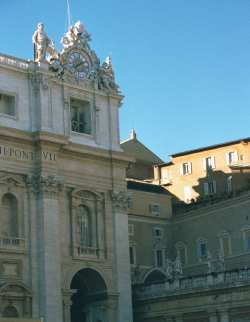
& The
Basilica of St. Peter
 |
The Vatican Museum & The Basilica of St. Peter |
On Monday morning, after a good nights sleep at the Hotel Albani, we were ready to take on Rome. We had a very good breakfast of bacon and eggs, and then several of us walked about two blocks from the hotel to find an ATM machine where we were able to use our bank cards to get Italian currency at a good rate and with very limited charges. Because the hotel was in a location that was almost impossible for a bus to approach or park, we were forced to walk each day about two blocks from the hotel to a busy street to load or unload our bus.
We made it just fine, and eventually made it to the parking lot of the Vatican Museum where we first met our Roman guide, Fedora. She was very knowledgeable and friendly, but not of the quality that we had grown accustomed with Shep. He had been truly amazing.
 | The Vatican |
The Vatican is the smallest state in the world. The entire country comprises only 108.6 acres. The Vatican is fully enclosed within walls that were completed between 1540 and 1640. It is located very close to the Tiber River very near Rome's historic center. It's name comes from the Vatican Hill dating back to the 5th century B.C.
We began our tour in the Courtyard of the Pine Cone (photo above). All of the buildings that today make up the museums were at one time or another the apartments of the popes. Today, the museums of the Vatican comprise one of the most valuable collections of art in the entire world. We toured a number of rooms and hallways and saw many wonderful masterpieces. However, I captured very few photographs. The photo below was of the ceiling of a very long hallway. Our guide pointed out that even though the art work on the ceiling appeared to show at least several inches of relief, it was actually, a totally flat painting. The other photograph is of the beautiful "Sphere within Sphere" by Arnaldo Pomodoro commissioned by the Vatican in 1990.
The Sistine Chapel is the Pope's private chapel. It is also the place where the Cardinals gather after the death of a pope to select the next pope. The ceiling was painted by Michelangelo under contract by Pope Julius II in 1508 and was completed on November 1, 1512. It tells the entire story of Genesis and focuses on the Creation of Adam in its center. The front wall of the chapel features Michelangelo's - Last Judgment. Christ ordered Peter to guide the Church throughout history. As a result, Peter came to Rome in about 42 A.D. Then sometime between 64-67 A.D., at the height of of the anti-Christian persecutions, Saint Peter was martyred (crucified upside down) in Nero's Circus at the foot of Vatican Hill. His body was entombed in a nearby burial ground. Peter's tomb is the reason for all that exists in the Vatican to this day.
Next to Peter's tomb, which lies directly beneath the altar of St. Peter's, repose the remains of 147 popes including all of those who have led the Church in this century.



Sistine Chapel

The Basilica of St. Peter
 |
 |
 |
 |
 |
 |
 |
 |
 |
 |
 |
 |
 |
 |
 |
 |
 |
 |
| Stop the Tour | Tour Index Page | Today's Index Page | Today's Next Stop |